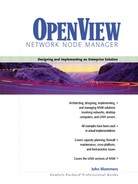Introduction
For small networks a single Network Node Manager (NNM) system may suffice, but large, multisite worldwide networks will need many NNM systems. A formal project plan is needed for larger implementations to ensure a successful deployment. This plan must cover the following aspects of network management:
A requirements analysis is best performed early in the project because of the obvious downstream impact that occurs should the rate of change of the requirements exceed the rate of engineering. The requirements analysis explores the number of NNM systems to be deployed, how many active users are expected, what transaction response times are acceptable, the number and kinds of maps users will need, what reports are needed, what devices should be managed, the security implications, and reliability and uptime issues.
The NNM deployment project plan should be alive and shared with the user community. A web site is ideally suited for sharing documents, including the project plan, operations agreements, configuration guides, best practices, and product manuals. PDF format is the ideal format for shared documents.
The operations agreement documents what features and capabilities the NNM deployment is supposed to provide to the user community. It represents the requirements as seen from the user perspective and includes roles and responsibilities. This agreement is developed early in the project cycle.
An absolutely critical step in the project plan is choosing a scalable computer platform that ensures users get good NNM performance for many years. This means the system has expansion capabilities for CPU, disk, RAM, and network connectivity.
A pilot test is crucial to ensure the success of a large NNM deployment. Lessons learned here help to build confidence, and sites participating in the pilot test become allies and advocates for the new capabilities NNM brings. You will also discover information about the network infrastructure that is valuable in steering the impending deployment around difficult network devices and configurations.
The project plan also provides a training schedule for the user community. Depending on their role, users may require the shorter operator training or the full operator and administration class. Timing and budget constraints will determine if on-site training is appropriate.
Most large corporate networks are geographically dispersed and serve multiple logical business entities. The IT group will therefore deploy multiple NNM systems and each will operate in its management domain. Experience during the pilot test will help determine the best way to configure each NNM system so that the actual network topology it manages corresponds very closely with the desired model.
Planning for ongoing problem resolution in support of the NNM deployment means formalizing a support plan, recruiting a support staff, defining a problem escalation plan, and publishing procedures. This includes a formal support staff list, a list server for general technical discussions, and an NNM test lab for problem duplication, testing, and development.
A backup strategy is needed in the event that data is lost due to a hardware failure, or if a database is corrupted, a user deletes a file or map inadvertently, there is a change in requirements, or a patch or upgrade must be rolled out. The strategy should minimize scheduled downtime.
For large NNM deployments, there is good reason to consider HP’s IT Operations product for system administration of the NNM systems. This allows a central site to monitor the critical resources of each NNM system, upload patches, perform backups, manage the print spooler, execute periodic health checks, and perform general system administration.
There is incredible value in recruiting one or more experienced consultants, system administrators, and project managers into the NNM deployment team. These people can provide the necessary personnel resources and expertise that may not be easily drawn from the exist-ing IT group. This helps ensure that project’s success and timely completion.
A victory celebration is recommended upon the successful completion of the NNM deployment project.
Support for the NNM systems has to be planned after they are deployed across the corporate network. A schedule to apply patches should be created that minimizes downtime and risk. Minor and major NNM releases may require wholesale software upgrades. You may also find that more users are taking advantage of the NNM systems which may require some of them to be upgraded to maintain satisfactory performance levels.
